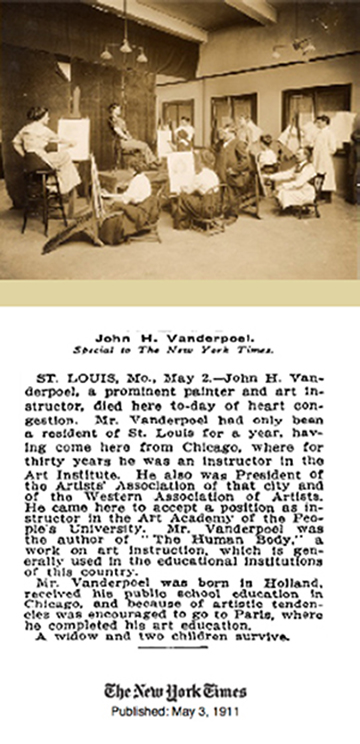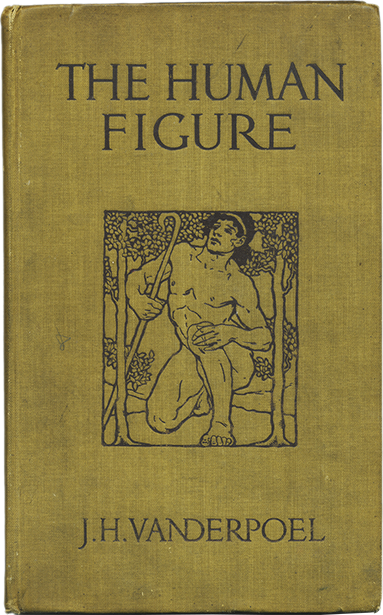The history of John Vanderpoel

Born in Holland
(November 15, 1857 – May 2, 1911), born Johannes (Jan) van der Poel, was a Dutch-American artist and teacher, best known as an instructor of figure drawing. His book The Human Figure, a standard art school resource featuring numerous of his drawings based on his teaching at the Art Institute of Chicago, was published in 1907.
Life and work
Vanderpoel was born in the Haarlemmermeer, Netherlands, the seventh of ten children. His mother died in 1867, and in 1869 he emigrated with his father and siblings to the United States. He studied at the Chicago Academy of Design, which later became the School of the Art Institute of Chicago. In 1886 he went to Europe, studying for two years at Academie Julian in Paris with Gustave Boulanger and Jules Lefebvre.
Source: Wikipedia

World’s Columbian Exposition
Vanderpoel exhibited five paintings at the World’s Columbian Exposition in Chicago in 1893,[4] was a member of several artists’ societies, and was elected president of the Chicago Society of Artists.[3] He received a bronze medal at the Louisiana Purchase Exposition of 1904 in St. Louis. He worked with Lucille Wilcox Joullin during his stay in Chicago. Vanderpoel also created murals, including one on the ceiling of a theater at DePaul University and a sixty-foot painting at a Los Angeles hotel.[5] In spite of his successes as a muralist and easel painter, Vanderpoel was better known as an instructor at the Art Institute,[3] where he taught from 1880 until 1910. He was an influential teacher who adhered to the beaux-arts tradition while denouncing modernism.[2] Among Vanderpoel’s many students were artists J. C. Leyendecker,[6] Frederick Carl Frieseke,[7] and Georgia O’Keeffe, who wrote in her autobiography that Vanderpoel was “one of the few real teachers I have known.”[4][5][8] Vanderpoel’s younger sister Matilda, an artist who, like him, had attended and then taught at the Art Institute, also had O’Keeffe as a student.
Source: Wikipedia

People’s University Art Academy
In 1910, Vanderpoel moved to St. Louis, accepting an offer from Edward Gardner Lewis to join the faculty of People’s University as head of the Art Academy’s drawing and painting department.[11] He died in St. Louis on May 2, 1911, of heart disease,[3] and was survived by his widow and two children.[12] Two years after his death, the Vanderpoel Memorial Art Galleries were established in Chicago’s Beverly Hills neighborhood. The collection features works by Vanderpoel, including drawings that were published in The Human Figure, as well as those of other artists associated with Chicago. The collection now numbers over five hundred pieces.[4] A street and an elementary school in Chicago are also named in his honor.[8]
Source: Wikipedia

The Human Figure
Vanderpoel had developed a reputation as one of America’s foremost authorities on figure drawing. His book The Human Figure, published in 1907, featured many of his pencil and charcoal drawings, and became a standard textbook for art school students.[2] George Bridgman wrote in a foreword included in some editions of the book: “[Vanderpoel’s] insight into nature was the result of a lifetime of earnest, patient and persistent study. He analyzed and recorded the human figure both in mass and detail; in good taste and discriminating judgment, with a closeness to nature that has never been equaled. The features “… will always remain a masterpiece in art… Mr. Vanderpoel has left behind him a great and powerful influence.”[10]
Source: Wikipedia

The Ridge Park gallery
By 1919, the collection was designated a museum, and in 1922 Watson, another former instructor at the School of the Art Institute, donated a watercolor, “Hollyhock Cottage,” which he painted at an art colony in New York. The painting hangs in the Vanderpoel Gallery at Ridge Park. The Ridge Park gallery was built in 1929; before that, the collection appeared at the Vanderpoel school at 9510 S. Prospect Ave. in Beverly. “It outgrew the school quite quickly,” Testa said as she gave a tour of the Ridge Park gallery. “The school still has paintings from the association.” Among the Ridge Park gallery collection is Vanderpoel’s “The Cup That Cheers.” As a young man, Vanderpoel entered the Chicago Academy of Design, which was founded in 1866. By 1882, it had evolved into the School of the Art Institute of Chicago, and Vanderpoel served as an instructor there for 30 years, until his retirement in 1910. Many of the paintings at the Ridge Park gallery depict Chicago scenes. A Raymond Johnson landscape, “Crooked Trees in Sunlight,” was painted at the Lincoln Park Lagoon in 1916. The gallery also has a Frederick Milton Grant landscape, “Century of Progress Fair 1933.”
Source: Chicago Tribune article by By Scott Broden, June 11, 1995
The gallery has reopened and is now accessible by elevator.
Open Tuesdays & Thursdays 1:00 – 4:00 p.m. and Saturdays 10:00 a.m. – noon.
Call 773-294-8311 for information or an appointment.
Gallery closed for the summer as of June 24, reopening on August 12.
Ridge Park Fieldhouse, 9625 S. Longwood Drive, Chicago, IL 60643
Send donations and correspondence to: 10429 S. Seeley Ave., Chicago, IL 60643
